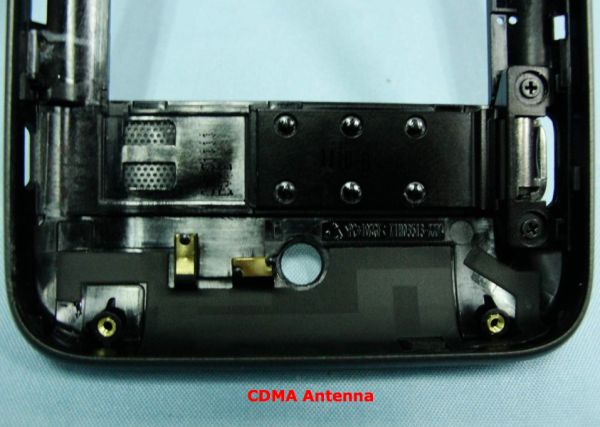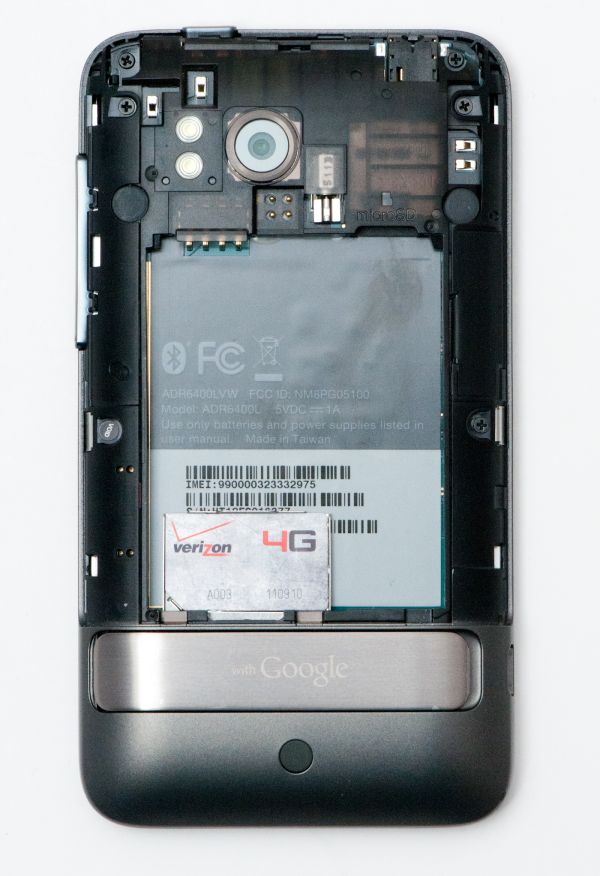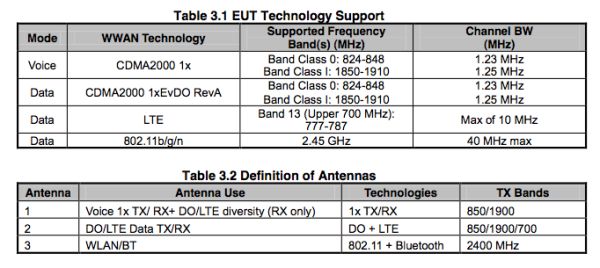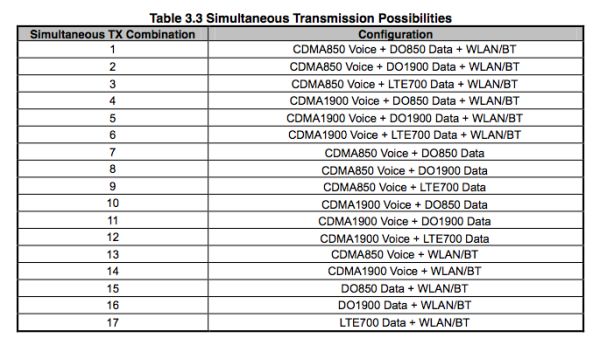HTC Thunderbolt Review: The First Verizon 4G LTE Smartphone
by Brian Klug on April 27, 2011 12:12 AM EST- Posted in
- Smartphones
- HTC
- Verizon
- LTE
- 4G
- Android
- HTC Thunderbolt
- Mobile
- MDM9600
- MSM8655
A Tale of Two Cellular Radios
I suppose now is as good a time as any to delve into the dual transceiver situation on the Thunderbolt. The two transceivers I speak of are the MSM8655’s built in cellular baseband (like all Qualcomm SoCs, you get a modem for free), and the MDM9600 which sits at the heart of every single other Verizon LTE product except the LG VL600 data card, which uses LG’s own L2000 chipset. If you want the short story, the Thunderbolt fully supports simultaneous CDMA2000-1x voice and 3G EVDO or 4G LTE data. The way this is done should already be somewhat obvious - the MSM8655 gives the Thunderbolt a continual free CDMA 1x connection for voice, SMS, and slow data, and the MDM9600 does all the 3G EVDO and 4G LTE data heavy lifting. What this boils down to is real SVDO (Simultaneous Voice Data Optimized) and SVLTE (Simultaneous Voice and Long Term Evolution data).

You can see proof of this in the Thunderbolt’s EPST menus, where there’s a second additional field marked “9k” which clearly is for the MDM9600 (9600, 9k, ahh right).
This situation also starts to become clear when you pry the battery cover off the back of the phone. Getting the battery cover off is incredibly difficult the first time. I swear I almost broke the thing the first time I did it. There are seriously more than ten plastic clips and guides which hold the door securely in position.
The Thunderbolt comes by default with a 1400 mAh, 3.7 VDC (5.18 Whr) battery (the official extended battery is 2750 mAh, 3.7 VDC, 10.18 Whr, as an aside). If you remove the battery, you can access the Thunderbolt’s USIM which slides out long ways first in a metal carrier. This is the first time I’ve seen a SIM door insert this way, but it works.
While we're talking about SIMs, Verizon's is technically both a CSIM and USIM. CDMA credentials are on the SIM (CSIM) as well as the credentials for LTE (USIM). The way the term SIM is abused lately for anything resembling one will likely continue, but if you're going to be pedantic, it's really both. Anyhow, as a result, you can finally swap devices on Verizon without having to call support, give them an ESN, and wait for routing tables to switch everything over. I haven't personally tried it since I don't have two Thunderbolts, but Verizon does advertise this is as a notable feature that finally brings full device portability. This is a huge feature if you intend to swap between devices a lot.
The reason why it’s held on so securely makes sense the second you get it off - there are two antennas back here built into the door. The reason for such a stiff and beefy door is so that no fewer than four independent contacts need to be held in good electrical contact. Count them - two contacts for the top right connector, another for top left, and another for wireless induction charging if you go with the extended battery combo.
Though we never reviewed it formally, the myTouch 4G was the first time I saw HTC start to go down the modular antenna route, with a similarly detachable (internal) antenna board. The Thunderbolt does the same thing here, yet builds it into the battery door. Likewise, the HTC Desire HD does the same thing, as does the upcoming Sensation. It isn’t just Apple that gets creative with antennas now and then, HTC deserves some credit too.
The antenna on the left is for GPS and even bears a marking to that effect on the flex board. The one on the right is for the MDM9600 and thus works for data on LTE and EVDO. There are two holes which punch clean through to the opposite side, clearly to ensure good contact with whatever antenna is built into this battery door.
There are two more antennas on the Thunderbolt, bringing the grand total to four. There’s one in the flex style we’re used to seeing which curves around the back and is for WiFi and BT, and another at the bottom right where we’re used to seeing them for CDMA 1x.
 CDMA 1x Antenna at the bottom, Source: FCC
CDMA 1x Antenna at the bottom, Source: FCC
That’s a bit of a simplification too. If you’ve read anything about LTE or our other piece on it, you should know by now that a large part of the specification is mandatory multiple antenna support. At least on Verizon’s LTE network all devices need to be category 2 or 3, which means they must incorporate MIMO. The HTC Thunderbolt’s UL MIMO configuration is 1x2, meaning it has 1 transmit antenna and 2 receive antennas. The RF chains for both the MSM8655 and MDM9600 basebands are independent, however the two share an Rx antenna at the bottom in the traditional spot. This antenna serves as 1x voice Tx/Rx for the MSM8655, and EVDO/LTE Rx for the MDM9600.
The one at the top is EVDO/LTE Tx/Rx for the MDM9600. You can verify this yourself if you pry the back cover off the phone while in an LTE or EVDO data session - it goes away and you promptly fall back to slow 1x data. Pretty cool though.
I spent a lot of time on the phone with Qualcomm talking about the radios in the Thunderbolt and LTE in general. I ended up learning a ton more about the number of design challenges involved with making SVDO and SVLTE work for the first time and gained an appreciation for even more complexities than I expected.
First off, since this is the first phone (I’m aware of) with dual cellular transceivers that can be active at the same time, Qualcomm and HTC had to work with the FCC to establish proper testing to making sure the Thunderbolt meets FCC SAR (Specific Absorption Rate) requirements. Remember that although the HTC EVO 4G could have conceivably supported simultaneous 4G WiMAX and 1x voice, the feature was disabled and to my knowledge hasn’t ever been enabled. It’s for this reason - until the Thunderbolt no proper procedure for characterizing dual transceiver phones existed. (Update: Apparently the EVO does support simultaneous WiMAX data and 1x voice, thanks everyone!)
Architecting a dual-transciever cellular system that works properly with FCC SAR requirements necessitated some communication and logic between the MDM9600 and MSM8655 basebands. This is noted in addition in the FCC report for the Thunderbolt:
Although the RF circuits are independent for both transmitters, the chipset solution incorporated SVDO/SVLTE implementation does include electrical connections between the voice and data transmitters such that the device can coordinate the transmit power of both transmitters. That said, the transmitters operate independently in the sense that they independently support voice or data connection without interaction between the modems or signaling from the WWAN network.
It’s an edge case, but imagine a situation where you’re at cell’s edge transacting both LTE data and 1x voice. In that circumstance, SAR could theoretically exceed legal limits. To keep this from happening, that communication link between the MDM9600 and MSM8655 lets the Thunderbolt know the power and link budgets for both and allocate accordingly by reducing throughput on the data link. There are a whopping 17 Tx configurations that the Thunderbolt needs to support all while maintaining legal power budgets.
I tested endlessly trying to detect any 4G LTE speed degradation at the cell edge while on a voice call but never could notice anything appreciable.
This wouldn't be a complete review without a measurement to show whether the Thunderbolt is prone to deathgrip. Luckily thanks to the antenna diversity we've outlined, the Thunderbolt really isn't. I've done the due diligence of measuring the handset in our usual positions in both 3G and 4G environments.
| Signal Attenuation Comparison in dB - Lower is Better | ||||||||
| Cupping Tightly | Holding Naturally | Holding in Case | On an Open Palm | |||||
| HTC Thunderbolt - LTE | 5.3 | 2.5 | - | 4.4 | ||||
| HTC Thunderbolt - EVDO | 6.5 | 0.8 | - | 7.2 | ||||
| Verizon iPhone 4 | 16.5 | 15.5 | 9.0 | 7.9 | ||||
| LG Optimus 2X | 13.7 | 9.3 | - | 5.9 | ||||
| Nexus S | 13.3 | 6.1 | - | 4.3 | ||||
| Droid 2 | 11.5 | 5.1 | - | 4.5 | ||||
| BlackBerry Torch | 15.9 | 7.1 | - | 3.7 | ||||
| Dell Streak | 14.0 | 8.7 | - | 4.0 | ||||
| Droid X | 15.0 | 5.1 | - | 4.5 | ||||
| AT&T iPhone 4 | 24.6 | 19.8 | 7.2 | 9.2 | ||||
| iPhone 3GS | 14.3 | 1.9 | 3.2 | 0.2 | ||||
| HTC Nexus One | 17.7 | 10.7 | 7.7 | 6.7 | ||||
The Thunderbolt has noticeably less attenuation when held in a 4G LTE scenario, no doubt thanks in part to the fact that it's fully leveraging MIMO and also on a 700 MHz carrier. I was surprised to see that make any measurable difference. I also saw a considerable amount of variance before the number settled down, which to me definitely indicates some DSP deciding on what link it can reliably hang onto in LTE coverage. In 3G EVDO the picture isn't as complicated, again attenuation is low until you put flesh over both antennas like what happens when it's on an open palm.
















71 Comments
View All Comments
Brian Klug - Wednesday, April 27, 2011 - link
I've accidentally gone with graphs that lacked that data and updated them with the Thunderbolt results. Numbers from iOS 4.3 will be added shortly!Thanks for pointing that out!
-Brian
metafor - Wednesday, April 27, 2011 - link
There's a couple of things here. First is that Verizon's EVDO coverage is already pretty good. And instead of opting to go towards 1x Advanced, they've decided to go with a standardized LTE protocol instead to increase speeds; this is a good thing.Secondly, while HSPA networks can provide theoretical speeds compared to LTE, the real-world performance is far from the reality of that. OFDM is a far better modulation scheme compared to QAM when it comes to not just realistic peak bandwidth but also range and versatility that there really is no question that it should be the next generation of cellular.
name99 - Saturday, May 7, 2011 - link
"OFDM is a far better modulation scheme compared to QAM when it comes to not just realistic peak bandwidth but also range and versatility that there really is no question that it should be the next generation of cellular."OFDM and QAM are orthogonal issues.
OFDM is about how spectrum is allocated. Old school is to give each user one of a few dedicated fairly wide frequency bands while they are in a cell. This frequency may or may not work well for them and be appropriate to their needs.
OFDM splits the entire spectral range into lots of small frequency bands, and dynamically decides which user gets to use which of these bands, based on issues like both the user needs and how good transmission/reception to that user is at that particular time. In addition, it's easier for the receiver for apply a different equalization to each of these small frequency bands to undo the effects of echos on the received signal.
QAM is about the shape of the pulse that carries the information within each frequency band. The very specific details of this change from one spec to another, but to first order this is the same as its always been --- the same idea that was in use in 1980s modem, and I assume even earlier in things like microwave and satellite transmission.
As for ltcommanderdata's point, it is a mistake to assume that 4G is about higher peak speeds. Rather it is about
(a) a more consistent experience, so that data rates are less likely to fall off a cliff in bad conditions, like at the edge of a cell
(b) it is about better OVERALL use of the limited spectrum available. Under some conditions this will allow a few users to see very high speeds, but the more likely scenario in urban conditions is that it will allow more users in a cell to get acceptable speeds.
In other words, it's a way to achieve the goal you want --- better data coverage for more people --- but using technology that ultimately does a better job. Better in terms of spectral usage, and better in terms of more data throughput/dollar spent by the carrier.
alent1234 - Wednesday, April 27, 2011 - link
lucky for you verizon's LTE is 3G and not 4G. I think it's something like 3.9G. there is a new 3GPP spec almost every year. HSPA+ is 3.6 or 3.7G.real 4G is still a few years away
cmdrdredd - Thursday, April 28, 2011 - link
so? What's the problem? You get massive speed boosts anyhow which is what the consumer cares about. Nitpicking the little details of the network means jack.Omid.M - Wednesday, April 27, 2011 - link
Brian,How much of the battery drain would you say is due to the first gen LTE antenna? I mean, I assume at this point we can call it first gen, right?
The Thunderbolt is in an odd spot in the VZW lineup. I feel it was rushed to showcase LTE---which it has done a great job of---but the phone itself isn't impressive in any specific way. It's not necessarily faster than other phones, the screen tech isn't amazing, and it's just really thick.
I agree with you on the qHD point: why can't manufacturers put out qHD with non-pentile matrix? Manufacturing-wise, is there a hold up? Is it an issue of contracts with vendors that need to end? I don't get it.
I keep seeing these smart phones that really just fall short in a way you think they could easily deliver.
Oh, and I didn't see you mention HTC's infamous "bump charging." I hear it's an issue with the Thunderbolt, too. Thanks for the awesome review. Super in depth!
@moids
Brian Klug - Wednesday, April 27, 2011 - link
@moids,It's hard to say for certain really how much of that battery life hit is the second cellular modem. I originally intended to measure current on both of the MDM9600 modems with an in-line ammeter, but didn't get a chance last time I was in a 4G market. That'll come in the next couple of weeks though. Obviously having two modems is going to affect battery life. The thing gets warm, which to me always is a good indicator that it's using lots of power.
I don't believe there's any reason why we can't have a qHD screen without Pentile. Keep in mind though that Pentile lets you emulate a higher resolution without needing to have 3 subpixels per pixel.
I've definitely seen the bump charging situation show up on the Thunderbolt. The first couple initial charges definitely showed that bump charge behavior, later on it got better, but Smart Panel showed a similar trend to that infamous XDA devs thread. I haven't really messed around enough to speak too intelligently about that issue than to say that yes, it does seem to still be kicking around. Maybe the Pyramid/Sensation will change things. I hope!
-Brian
yibrushn - Wednesday, April 27, 2011 - link
I am in a wimax market and they mean 3G data in that quote. 4G and calls are definitely a goBrian Klug - Wednesday, April 27, 2011 - link
Interesting! I pinged Qualcomm and was going to wait for them, but updated the article already. Thanks for pointing that out!-Brian
Omid.M - Wednesday, April 27, 2011 - link
Got it!By the way, if you guys implement a perm link feature that's per comment, I can reference certain..."issues"...for vendors to check out ;)
I want the Bolt because 4G in the Bay Area is STUPID FAST but it just feels like a sidegrade from my Fascinate. I'm pulling 10-12 hours with HEAVY use, 14-17 with moderate use, and well over 24 hours if I barely use it (hah). But, it took me many tweaks and still room for more tweaks.
I'm almost making pre-loaded Gingerbread a requirement of my next phone; I don't trust carriers/vendors anymore with promises of timetables. Yes, it has come to that: the OS version should be considered a marquee "feature." Sad.
The day that vendors stop caring about being first to market and care more about putting out a POLISHED experience is when we'll start to see others follow suit. There's no reason to rush products other than to meet a deadline by the higher ups.
I think it's fair to say that the negative impact of an unpolished product is far more damaging to credibility than the positive impact of being first to market (novelty).
Hear me, Verizon & HTC?